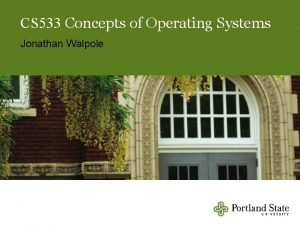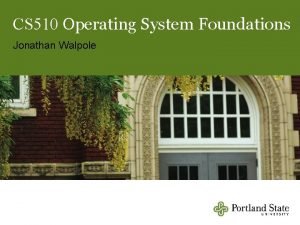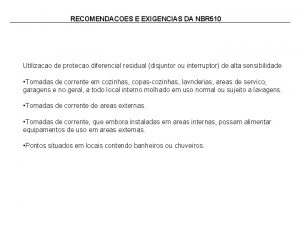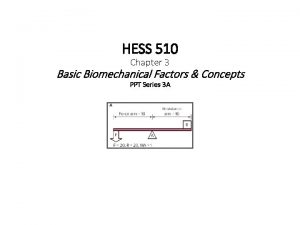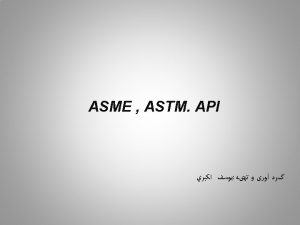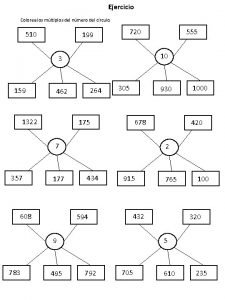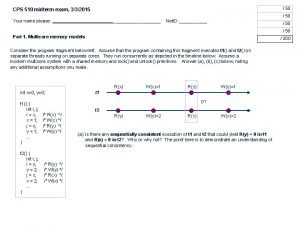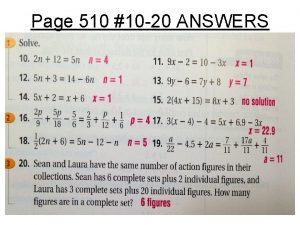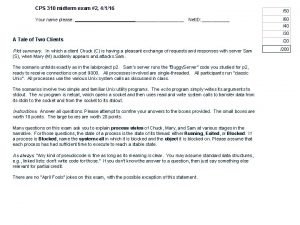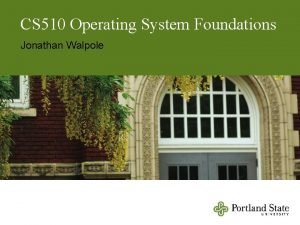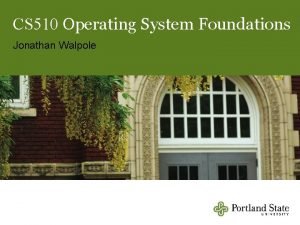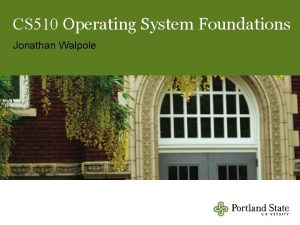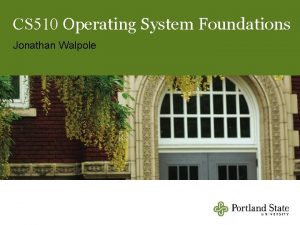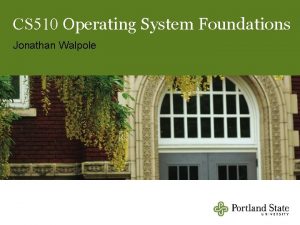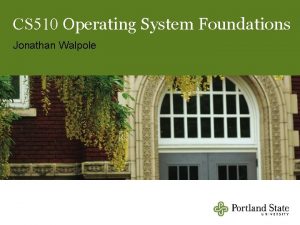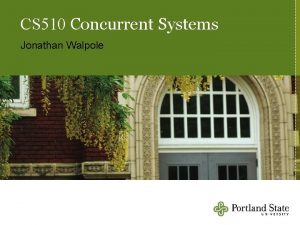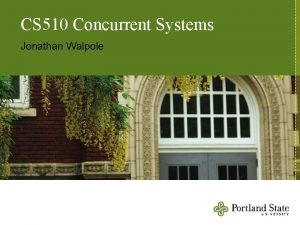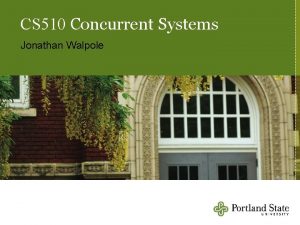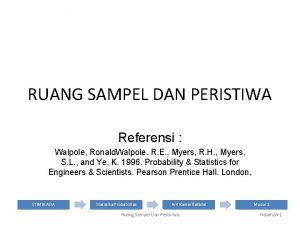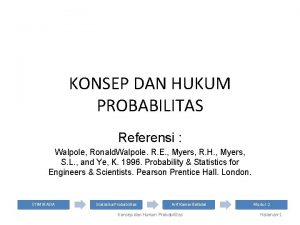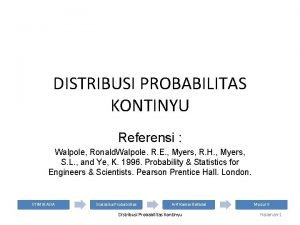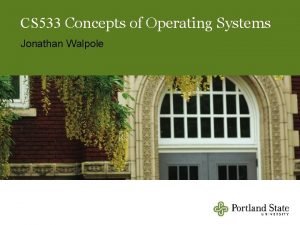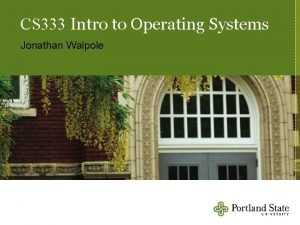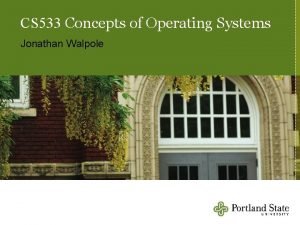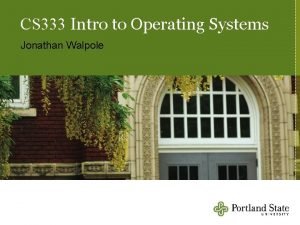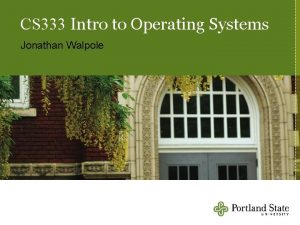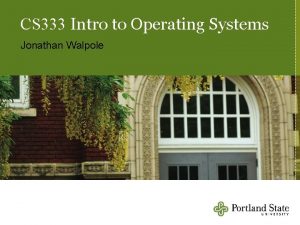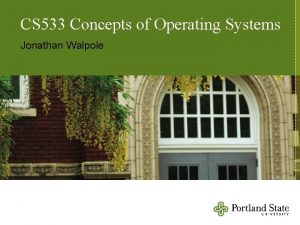CS 510 Operating System Foundations Jonathan Walpole Virtual


































- Slides: 34

CS 510 Operating System Foundations Jonathan Walpole

Virtual Memory (1)

Page Tables When and why do we access a page table? - On every instruction to translate virtual to physical addresses?

Page Tables When and why do we access a page table? - On every instruction to translate virtual to physical addresses? In Blitz, YES, but in real machines NO! In real machines it is only accessed - On TLB miss faults to refill the TLB - During process creation and destruction - When a process allocates or frees memory?

Translation Lookaside Buffer Problem: MMU can’t keep up with the CPU if it goes to the page table on every memory access!

Translation Lookaside Buffer Solution: - Cache the page table entries in a hardware cache - Small number of entries (e. g. , 64) - Each entry contains page number and other stuff from page table entry - Associatively indexed on page number ie. You can do a lookup in a single cycle

Translation Lookaside Buffer CPU p o page frame # # TLB Hit Physical memory f TLB Page Table o

Hardware Operation of TLB Key Page Number 23 17 92 5 12 Frame Number 37 50 24 19 6 Other unused unused D D D R R R W W W V V V

Hardware Operation of TLB virtual address 13 12 23 page number 0 offset Key Page Number 23 17 92 5 12 Frame Number 37 50 24 19 6 Other unused unused D D D 13 12 31 frame number physical address R R R W W W V V V 0 offset

Hardware Operation of TLB virtual address 13 12 23 page number 0 offset Key Page Number 23 17 92 5 12 Frame Number 37 50 24 19 6 Other unused unused D D D 13 12 31 frame number physical address R R R W W W V V V 0 offset

Hardware Operation of TLB virtual address 13 12 23 page number 0 offset Key Page Number 23 17 92 5 12 Frame Number 37 50 24 19 6 Other unused unused D D D 13 12 31 frame number physical address R R R W W W V V V 0 offset

Hardware Operation of TLB virtual address 13 12 23 page number 0 offset Key Page Number 23 17 92 5 12 Frame Number 37 50 24 19 6 Other unused unused D D D 13 12 31 frame number physical address R R R W W W V V V 0 offset

Hardware Operation of TLB virtual address 13 12 23 page number 0 offset Key Page Number 23 17 92 5 12 Frame Number 37 50 24 19 6 Other unused unused D D D 13 12 31 frame number physical address R R R W W W V V V 0 offset

Software Operation of TLB What - if the entry is not in the TLB? Go look in the page table in memory Find the right entry Move it into the TLB But which TLB entry should be replaced?

Software Operation of TLB Hardware TLB refill - Page tables in specific location and format - TLB hardware handles its own misses - Replacement policy fixed by hardware Software refill - Hardware generates trap (TLB miss fault) - Lets the OS deal with the problem - Page tables become entirely a OS data structure! - Replacement policy managed in software

Software Operation of TLB How can we prevent the next process from using the last process’s address mappings? - Option 1: empty the TLB on context switch New process will generate faults until its pulls enough of its own entries into the TLB - Option 2: just clear the “Valid Bit” on context switch New process will generate faults until its pulls enough of its own entries into the TLB - Option 3: the hardware maintains a process id tag on each TLB entry Hardware compares this to a process id held in a specific register … on every translation

Page Tables Do we access a page table when a process allocates or frees memory?

Page Table Usage Do we access a page table when a process allocates or frees memory? - Not necessarily Library routines (malloc) can service small requests from a pool of free memory already allocated within a process address space When these routines run out of space a new page must be allocated and its entry inserted into the page table - This allocation is requested using a system call

Page Table Design Page table size depends on - Page size - Virtual address length Memory used for page tables is overhead! - How can we save space? … and still find entries quickly? Three options - Single-level page tables - Multi-level page tables - Inverted page tables

Single-Level Page Tables 20 -bits 12 -bits page number offset frames in memory • • • Single-level page table

Single-Level Page Tables 20 -bits 12 -bits page number offset frames in memory • • • Single-level page table

Single-Level Page Tables 20 -bits 12 -bits page number offset frames in memory • • • Single-level page table Problem: requires one page table entry per virtual page!

Single-Level Page Tables 20 -bits 12 -bits offset page number frames in memory • • • Single-level page table 32 bit addresses and 4 KB pages means 220 page table entries per process

Single-Level Page Tables 20 -bits 12 -bits offset page number frames in memory • • • Single-level page table 64 bit addresses and 4 KB pages means 252 page table entries per process!

Multi-Level Page Tables frames in memory • • • Top-level Page table 2 nd-level tables

Multi-Level Page Tables 10 -bits PT 1 10 -bits PT 2 12 -bits offset frames in memory • • • Top-level Page table 2 nd-level tables

Multi-Level Page Tables 10 -bits PT 1 10 -bits PT 2 12 -bits offset frames in memory • • • Top-level Page table 2 nd-level tables

Multi-Level Page Tables 10 -bits PT 1 10 -bits PT 2 12 -bits offset frames in memory • • • Top-level Page table 2 nd-level tables

Multi-Level Page Tables 10 -bits PT 1 10 -bits PT 2 12 -bits offset frames in memory • • • Top-level Page table 2 nd-level tables

Multi-Level Page Tables 10 -bits PT 1 10 -bits PT 2 12 -bits offset frames in memory • • • Top-level Page table 2 nd-level tables

Multi-Level Page Tables 10 -bits PT 1 10 -bits PT 2 12 -bits offset frames in memory • • • Top-level Page table 2 nd-level tables

Multi-Level Page Tables Ok, but how exactly does this save space?

Multi-Level Page Tables Ok, but how exactly does this save space? Not all pages within a virtual address space are allocated - Not only do they not have a page frame, but that range of virtual addresses is not being used - So no need to maintain complete information about it - Some intermediate page tables are empty and not needed We could also page the page table - This saves space but slows access … a lot!

Address Translation Puzzle
 Jonathan walpole
Jonathan walpole Jonathan walpole
Jonathan walpole Demand paging in virtual memory
Demand paging in virtual memory Virtual memory in os
Virtual memory in os Buddy system operating system
Buddy system operating system File system in operating system
File system in operating system Ufs4.0
Ufs4.0 File system in operating system
File system in operating system Nbr510
Nbr510 La cultura romana 510-44 a.c
La cultura romana 510-44 a.c Toefl itp 510
Toefl itp 510 Cos 510
Cos 510 510 factors
510 factors Cs510 uiuc
Cs510 uiuc Api 2201
Api 2201 Chhi 510 book summary of turning points by noll
Chhi 510 book summary of turning points by noll Sa on opening balances
Sa on opening balances Dit is mijn verlangen tekst
Dit is mijn verlangen tekst Thermes du mans 50 à 200 après jc
Thermes du mans 50 à 200 après jc Licznik pewnego ułamka jest równy 10
Licznik pewnego ułamka jest równy 10 510 es múltiplo de 3
510 es múltiplo de 3 Problems on photoelectric effect
Problems on photoelectric effect Acs 510
Acs 510 Arad=v^2/r
Arad=v^2/r Number 510
Number 510 Cps 510
Cps 510 Upc 2-510
Upc 2-510 510 pred kristom
510 pred kristom Rtn510 huawei
Rtn510 huawei Page 510 geometry answers
Page 510 geometry answers Volume prisma belah ketupat
Volume prisma belah ketupat Averages bingo
Averages bingo Cps 510
Cps 510 Cps 510
Cps 510 1-800-510-2020
1-800-510-2020
